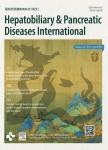Management of hepatocellular carcinoma patients with portal vein tumor thrombosis:A narrative review
Management of hepatocellular carcinoma patients with portal vein tumor thrombosis:A narrative review作者机构:Department of GastroenterologyQilu HospitalCheeloo College of MedicineShandong UniversityJinan 250012China
出 版 物:《Hepatobiliary & Pancreatic Diseases International》 (国际肝胆胰疾病杂志(英文版))
年 卷 期:2022年第21卷第2期
页 面:134-144页
核心收录:
学科分类:1002[医学-临床医学] 100214[医学-肿瘤学] 10[医学]
主 题:Hepatocellular carcinoma Portal vein tumor thrombosis Transarterial chemoembolization Radiotherapy Surgery Sorafenib
摘 要:Background: Hepatocellular carcinoma(HCC) is one of the main reasons for malignancy-related death. Portal vein tumor thrombosis(PVTT) is the most common form of macrovascular invasion related to HCC occurring in 10%-60% of patients. HCC with PVTT is usually characterized by worsening liver function, vulnerability to blood metastasis, higher incidence of complications associated with portal hypertension, and intolerance to treatment when compared with that without PVTT. If only treated with supportive care, the median survival of HCC with PVTT is about 2.7 months. In the past, sorafenib was the only recommended therapy by guidelines with limited effectiveness. This narrative review aimed to describe the current management options for HCC with PVTT. Data sources: We have reviewed literature from Pub Med on the treatment of HCC with PVTT and compiled evidence-based facts on effective therapies available for different types of PVTT. Results: Sorafenib monotherapy is not much effective, but combining it with other methods can improve survival. Each type of PVTT can beneft from the combination of transarterial chemoembolization and sorafenib than sorafenib monotherapy. The tumor downstaging can be realized possibly after transarterial chemoembolization, but tumor invasion into the main trunk of the portal vein greatly impairs efficacy. Although surgery is a curative approach, it is often not recommended for Vp4 PVTT. Some new methods can broaden the indication, but further explorations are needed. Radiotherapy can decrease the possibility of Vp3 progression to Vp4, but building a forecast model of best radiation dose and response is necessary. Systemic chemotherapy, hepatic arterial infusion chemotherapy, radiofrequency ablation, portal stenting, and traditional Chinese medicine are also benefcial in Vp3-4 PVTT. The accurate diagnosis of PVTT can be made by radiomics, and prognostic classifcation models can be used to design personalized treatments. The application of new



